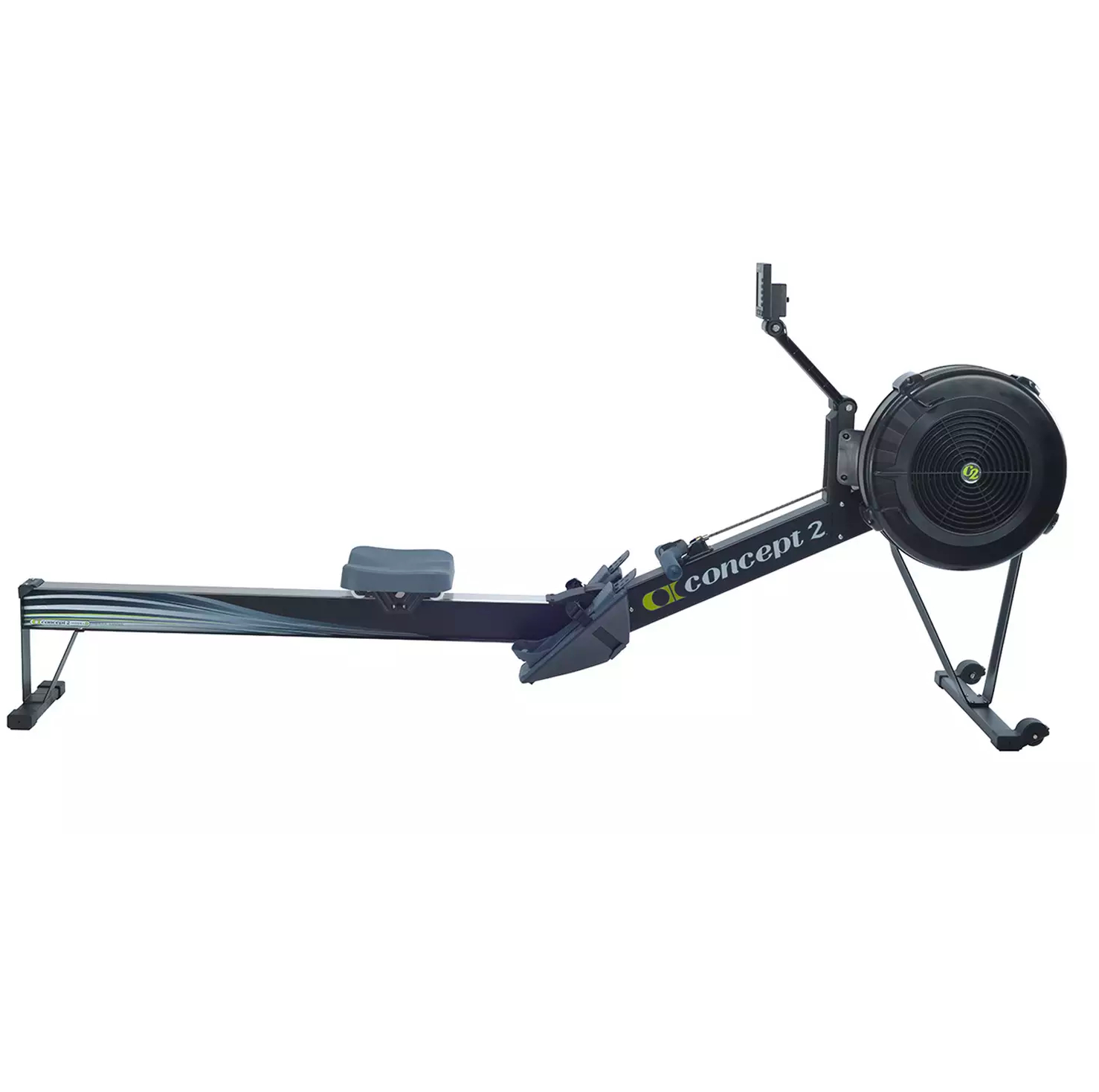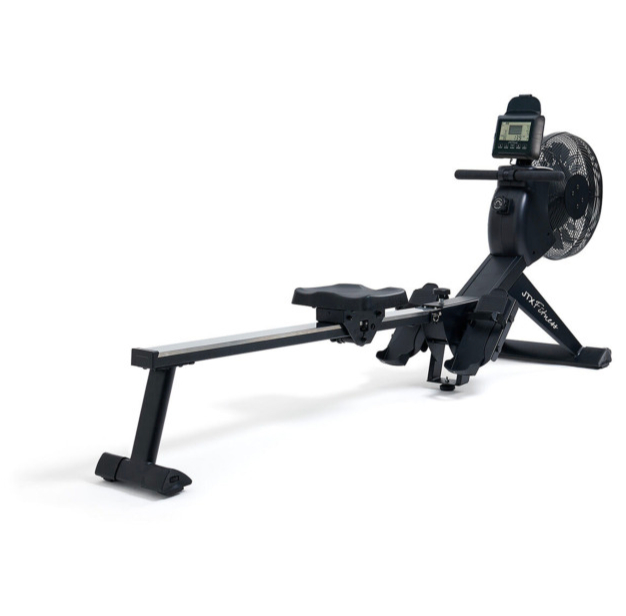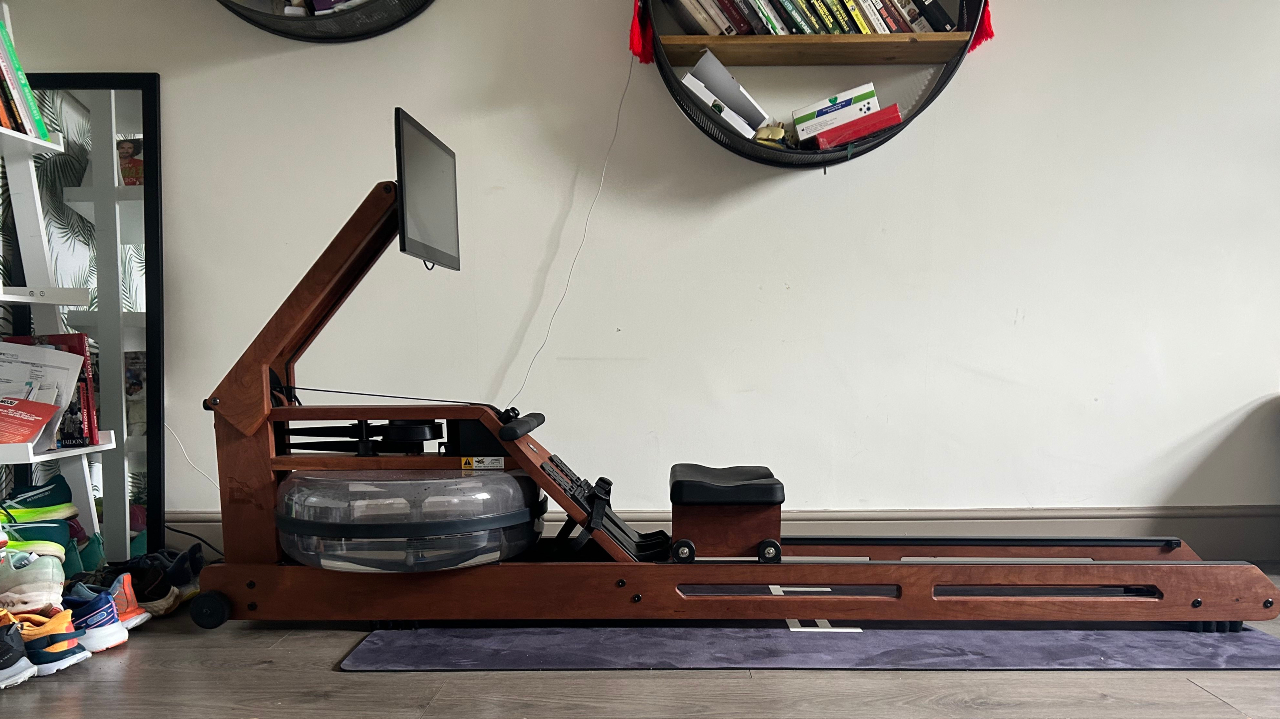The Best Rowing Machines For Home
Expert recommendations for a range of budgets based on long-term reviews of the best rowing machines

1. The quick list ↴
2. Best rowing machine: Concept2 RowErg
3. Best for beginners: Hydrow Wave
4. Best folding rowing machine: JTX Freedom Air
5. Best magnetic rowing machine: ProForm 750R
6. Best water rower: Ergatta Rower
7. Best compact rowing machine: Bluefin Fitness Blade 2.0
8. Best for building muscle: Technogym SkillRow
9. Compare rowing machine specs
10. Rowing machine buyer’s guide
If you have space for only one cardio machine in your house, it’s difficult to make a case for anything other than the rowing machine. Owning one of these means you can get a low-impact, full-body workout as well as improving your cardiovascular fitness, any time you want.
There’s also one straightforward stand-out pick which isn’t the most expensive rowing machine—the Concept2 RowErg. It’s used by Olympians and is hardy enough to feature in commercial gyms.
You can still find a good machine for less, and rowing machines have also caught up with the best exercise bikes and best treadmills by connecting to subscription apps for follow-along video workouts. These are especially useful if you need a primer on rowing form and could do with some help planning your workouts (although our rowing workout plan does the same and it’s free). Hydrow is our top pick of this type of rowing machine, but Echelon and ProForm offer a similar experience for less money.
Peloton has released its connected rowing machine, the Peloton Row, in the US, and the brand’s exercise bikes and treadmills really are best in class. However, we haven’t been able to test it yet and won’t include it on this list until we do.
If you’d like to know more about the types of rowing machines available and the range of features on offer we have a buying guide below which is full of expert advice and the benefit of our experience reviewing rowing machines.
How I Test
You can trust Coach

I’ve been reviewing rowing machines for Coach since 2020 and my recommendations are based on long-term home testing of 10 rowing machines. As Coach’s only rowing machine reviewer, I’m one of the few people to have spent significant time using both budget machines that cost hundreds and top-of-the-range connected models in the thousands. I’ve also tried every type of resistance you’ll find in home rowing machines: water, air and magnetic resistance, and some models that combine air and magnetic resistance.
Testing rowing machines at home means I get to experience setting up the rower, how loud it is when in use, and how easy it is to move around and store—practical considerations that are just as important as what it’s like to use. I use the rowing machines for a minimum of three weeks, making sure I try all the pre-set and connected workout types available. When it’s a straightforward budget machine, I dip into Coach’s rowing machine workouts and rowing workout plan.
The Quick List

The Concept2 RowErg is my top pick because it nails the fundamentals. It’s well built, it’s easy to assemble, it performs flawlessly and it also works with rowing fitness apps so your training won’t start to feel stale. It’s also more affordable than many of the new breed of connected rowers.

If you’re starting out and want to be taught the basics and led through workouts by likable trainers, buy the Hydrow Wave. It’s smaller than the original Hydrow, but offers largely the same experience with magnetic resistance and a slick app that will keep you coming back for more.

If space is at a premium and you want a rower you can quickly bring out then pack away again, the JTX Freedom Air is the ideal choice. The rail folds up and it can be wheeled around easily. It’s an air resistance-based rower that will suit indoor rowing newcomers best and usefully offers the ability to pair Polar heart rate monitors to better measure how hard you rowed.

If silent magnetic resistance appeals, I recommend the Proform 750R. It offers a wide range of magnetic resistance levels and if you pay for the comparatively cheap iFit companion app, virtual trainers will control the resistance in the on-demand classes.

Ergatta takes a WaterRower and adds a screen so you can play fitness games and race others on the rowing machine memorably featured in Netflix’s House Of Cards. The wooden body also makes it one of the easiest rowers to move around and it can be stored upright.

This rower feels dinky in comparison to other models on this list and the rail can also be folded up. The levels of resistance will leave regular exercisers wanting more, but it’s a good pick for beginners, occasional exercisers or seniors.

The Technogym Skillrow offers an additional power mode which adds a lot of magnetic resistance to make each stroke a kind of pull exercise you can do to develop strength and power. It’s also a consummate gym-grade rowing machine, with a price to match.
Best rowing machine

Specifications
Reasons to buy
Reasons to avoid
The Concept2 RowErg deserves its reputation as a well-built workhorse. It stood out from the off by being more straightforward to assemble than other rowers I’ve tried. It feels built to last, but surprisingly isn’t as cumbersome to maneuver as similarly-priced rowers.
The air resistance offers a similar feel to rowing on water and the damper means you can change the drag factor so each pull feels lighter or heavier. The flywheel also wasn’t as noisy as I expected it to be.
The display feels dated, but it’s readable and includes every metric you could want. It also includes a useful selection of pre-set workouts, including, to my surprise, some enjoyable gamified options.
The RowErg can connect to third-party apps too, and there’s a smartphone/tablet holder under the screen to follow video workouts. I tried it with the subscription app Fiit, which offers well-designed classes that push you hard. There were a few drop-outs, but it wasn’t clear which component was at fault, and overall it didn’t detract from the experience.
The Concept2 RowErg isn’t cheap, but it’s a lot cheaper than many smart rowers, and the connected app subscriptions are also cheaper than those offered by Hydrow and Ergatta. All in all, the RowErg’s design, features and extra smarts means it easily justifies its price.
Read more in my Concept2 RowErg review
Best rowing machine for beginners

Specifications
Reasons to buy
Reasons to avoid
Hydrow earned the title of the Peloton of rowing machines at launch, with a sleek-looking rowing machine and an easy-to-use app full of engaging classes and scenic rows. The Hydrow Wave is the follow-up which takes up less space, has a smaller screen and costs a lot less. It retains the well-designed workouts led by likable trainers, training programs and technique tutorials, though, making the Hydrow Wave the obvious choice for most people.
At $1,495/£1,595 it’s still at the more expensive end of smart rowers and the membership is $39/£38 a month too. But everything—from the hardware to software—is user-friendly and it helps beginners learn the correct rowing form to reduce the risk of injury. The Hydrow Row will also continue to pose a challenge as you get fitter for years into the future. If you have the money, it’s the smart choice.
Read more in my Hydrow Wave review
Best folding rowing machine

Specifications
Reasons to buy
Reasons to avoid
A folding rowing machine is the way to go if you don’t have a lot of room to play with. With the JTX Freedom Air, you’re getting a good-sized option that is a bit on the tall side, but does offer a simple folding design along with wheels to make maneuvering it around a room easier to do.
It’s not the only folding indoor rower out there, the ProForm 750R, Echelon Row and BlueFin Fitness Blade 2.0 (below), all have a rail that hinges upwards, but I found JTX’s simple system the best of the options I tried. It’s only available in the UK, so I’d point Americans in the direction of the ProForm 750R.
The stroke action is good, with a magnetic-based resistance system adding extra resistance on top of that provided by the flywheel. Given the air resistance, it’s not especially noisy when in use. It only offers basic workout programs and connectivity is limited to Polar heart rate monitors.
It may prove a little lacking for more seasoned indoor rowers and I found it did move about on hard floors when rowing at higher intensities.
It’s a good option for beginners or someone looking to buy a rowing machine that complements wider training goals, rather than buying a rowing machine as the only workout option you use.
Read more in my JTX Freedom Air review
Best magnetic rowing machine

Specifications
Reasons to buy
Reasons to avoid
If you don’t want your rowing to disturb the people you live with, get a rowing machine with magnetic resistance. I rate the ProForm 750R as a great-value pick.
It’s quiet and the stroke action feels smooth. There are also 24 levels of resistance, which are put to good use in companion app iFit’s connected rowing workouts where the resistance changes automatically according to the virtual trainer’s instructions. iFit requires a subscription, but it’s significantly cheaper than companion apps from Hydrow, Ergatta and Echelon. It lacks the live classes you’ll find on Hydrow and Ergatta, but I enjoyed the mix of studio classes and scenic outdoor rows on offer.
Although it can fold, the 750R is big and heavy and I’d plan on having a dedicated space for it—ideally somewhere next to a socket since it needs to be plugged in. You also need to supply your own screen for the connected workouts and it’s best if you have a tablet. I found the clamp on the holder can press the buttons on the side of a smartphone.
As long as you have the space, tablet and modest budget for the ongoing app subscription, you’ll get a solid rower that won’t annoy the neighbors or the person in the next room trying to watch TV.
Read more in my ProForm 750R review
Best water rower

Specifications
Reasons to buy
Reasons to avoid
The Ergatta is a connected rower that is very expensive. It’s $2,499/£2,495 up front and membership to the continually-evolving gaming-centric platform is $29/£29 a month.
You do get what you pay for, though. The WaterRower is a beautifully made machine and is a pleasure to row. I liked that it was delivered in multiple boxes so it was much easier to carry inside, and once set up it has a smaller footprint compared with other smart rowers.
The WaterRower is available without the Ergatta integration, but many people will find the gamified approach more motivating than rowing under their own steam or watching PTs in fitness studios telling you what to do. If that sounds appealing, Ergatta will be well worth the extra outlay. Or consider the Ergatta Lite, launched at the end of 2023, a smaller, lighter and cheaper second-generation model.
Read more in my Ergatta review
Best compact rowing machine

Specifications
Reasons to buy
Reasons to avoid
The Bluefin Fitness Blade 2.0 is by far the smallest rowing machine I’ve tested and the most affordable, often available for well below its $399/£359 list price. That means there’s more plastic used than on other rowing machines, but it at least makes it light and easy to set up.
The footplates and seat do feel better suited to smaller frames, while you’re getting a pretty basic LCD screen to check your stats up ahead. It does connect to a companion app, but it’s pretty basic.
It uses magnetic resistance so it’s relatively quiet when in use, but the range of resistance levels will leave more experienced indoor rowers wanting more.
All the same, it’s a compact rowing machine that offers a good-enough rowing experience and undercuts everything else on this list.
Read more in my Bluefin Fitness Blade 2.0 review
Best rowing machine for building muscle

Specifications
Reasons to buy
Reasons to avoid
The Technogym SkillRow is a gym-grade rowing machine with a big metal frame that can handle whatever you can throw at it. It also has a unique power mode which adds so much extra magnetic resistance on top of that provided by the flywheel that you can perform reps of the stroke to develop strength and power.
It also operates as an excellent connected rower, although you need to supply a tablet or phone to sit above the big, bright screen which displays your stats. You’re not restricted to using just Technogym’s own app either, which isn’t the case with Hydrow, Peloton or Ergatta.
That hulking frame can be separated into two parts to make it a little easier to put away, but this is one ideally that you’ll have a permanent spot for.
It’s considerably more expensive than most smart rowers and a few thousand dollars more than our top rower pick the Concept2 RowErg, but the power mode does offer something no other rowing machine does.
Read more in my Technogym Skillrow review
Compare Rowing Machine Specs
| Product | Resistance | Max user weight | Length | Width | Height | Weight (unboxed) |
|---|---|---|---|---|---|---|
| Concept2 RowErg | Air | 500lb / 227kg | 96in / 244cm | 24in / 61cm | 41.9in / 106.5cm | 57lb / 26 kg |
| Hydrow Wave | Magnetic | 375lb / 170kg | 80in / 203cm | 19in / 48cm | 43in / 109cm | 102lb / 58kg |
| JTX Freedom Air | Magnetic | 298lb / 135kg | 90.6in / 230cm | 21.7in / 55cm | 34.7in / 88cm | 88lb / 40kg |
| ProForm 750R | Magnetic | 250lbs / 113kg | 86.6in / 220cm | 22.1in / 56cm | 45.7in / 116cm | 116lb / 52kg |
| Ergatta | Water | 500lbs / 227kg | 86in / 218cm | 23in / 58cm | 40in / 101cm | 103lb / 46.7 kg (with water) |
| Bluefin Fitness Blade 2.0 | Magnetic | 220lb / 100kg | 65in / 166cm | 20in / 51cm | 29in / 74.5cm | 46lb / 21kg |
| Technogym SkillRow | Air and Magnetic | 352lb / 160kg | 96in / 243.5cm | 25in / 63cm | 50in / 128cm | 134lb / 61kg |
Rowing Machine Buyer’s Guide
Types of rowing machine
Rowing machines can be categorised by the type of resistance they offer – air, magnetic or water. Each has a distinctive feel and sound.
When you row on an air rower, air passes through a flywheel, and typically the amount of air allowed to flow through is controlled by a damper at the side of the wheel, which can be moved up and down. Having the damper on high enables you to use the rower for a strength workout, whereas a low setting gives a lighter, faster feel that’s great for cardio. The main drawback of air resistance rowing machines is that they can be noisy.
The resistance in magnetic machines is provided by – wait for it – electromagnets. This type of resistance is found at the cheaper end of the market, and on high-end connected rowers. Magnetic resistance tends to be quieter than air or water rowers and it’s easier to change the resistance level – there’s usually a dial within easy reach on cheaper models. Basic magnetic resistance can suffer from a uniform action, though, where the feeling of pressure stays the same throughout the stroke. It isn’t to everybody’s taste so it’s a good idea to try one before committing. Connected machines are able to improve the feel of the stroke to better replicate rowing on water with a combination of eddy current brakes and software.
The third and most stylish option is a water rower – the solid wood ones in particular can look great in your living room. They have a smooth feel and a distinctive whooshing sound which many people love. The disadvantages are that they can be heavy and expensive. There’s no easy way to alter the resistance, either – you have to pour more water into the tank or drain it.
Elite rowers tend to favour air resistance machines, according to world champion rower Matthew Tarrant, who is the founder of rowing training platform RowElite. In part that’s because of the feel of the stroke. “You tend to feel most of the resistance during the first half of the stroke as you build the acceleration and move the flywheel,” he says.
Tarrant points out that the rowing machines most widely used by international rowing teams are the Concept2 and the RP3, both of which use air resistance. “Water rowers and magnetic machines are more for commercial use at the moment.”
What are the key features to look for on a rowing machine?
“My three main features are a comfy seat that slides up and down, a clear monitor that displays the relevant information, and the ability to check my resistance level [on an air rower] using the drag factor,” says Tarrant. “Having a seat that moves freely will help alleviate any excessive pulling on the hamstrings, a clear display helps you to stay consistent and accountable, and being able to see your drag factor means you can be certain that you’re always working with the same level of resistance rather than just trusting a damper setting.”
In truth, most casual exercisers won’t need (or want) to set a specific drag factor, which measures the speed at which the flywheel slows down. A low to medium damper setting an air rower will suffice (between 3 and 5 on a Concept2).
Check which statistics are displayed on the monitor before buying, especially if you are serious about rowing. If you will be taking part in indoor rowing competitions where there are standard metrics, the industry-standard Concept2 is your best bet. Keep an eye out for the inclusion of a heart rate metric as well: this indicates the machine can sync with a heart rate monitor. This can be a highly useful feature, especially when training to improve your cardio fitness.
How much do you need to spend?
The price range of rowing machines is wide, going from low three figures up to several thousand. Unusually, it’s not the case that the best rowing machine is the most expensive. The Concept2 RowErg doesn’t hit four figures, yet is considered among the best on the market. That’s not half bad for a machine that Olympians train on and that is used for setting world records in indoor rowing.
So why pay more? The more expensive rowing machines offer HD touchscreens, sophisticated companion apps, online fitness and rowing programmes, and interactive classes, although it’s possible to find pretty decent free resources online. Much will depend on whether you want a highly reliable, no-frills rower, or a slick and immersive experience, although bear in mind the latter will entail a monthly app subscription on top of the purchase price.
If you row on the water as well as indoors, you’ll probably have come across dynamic rowing machines. Instead of moving your body backwards and forwards on a monorail, these machines are designed so that your feet come towards you, mimicking the feel of rowing on the water. Some rowers swear that they are kinder to your back too.
The best-known dynamic rower, the RP3, costs a lot more than most static rowers but is radically different and may be worth the money if you take competitive rowing on water seriously. If you’ll only be rowing indoors and haven’t had rowing training, you might well struggle to master the distinctive motion and probably wouldn’t find the hefty price worth paying.
If you’re looking to spend as little as possible, you can still pick up a pretty decent rowing machine for half of what the Concept2 costs. If you just want to sweat, these rowers fit the bill, though do try to have a go on them before buying because some cheaper models can be a bit uncomfortable.
Other features to look out for
Some machines fold up or stand on end for storage. If you don’t have much space, this could be a game changer. Some rowers can be very heavy too. It’s something to bear in mind when considering delivery options, especially if you live in a top floor flat.
Finally, think about the sound of the machine. If you want something that just purrs gently, a magnetic rower is your best option, though you may find the sound of the water or air rower pleasingly mesmeric.
Whatever kind of machine you have in mind, and whatever budget you have, we’ve got the perfect rower for you in this round-up, ordered from least expensive to most.
Sign up for workout ideas, training advice, reviews of the latest gear and more.

Mike is an experienced journalist, beginning his career in 2008, and is a keen runner and swimmer. As a contributor to Coach, he covers swimming and reviews rowing machines.
- Jonathan ShannonFormer editor
- Patricia Carswell
- Nick Harris-FrySenior writer
